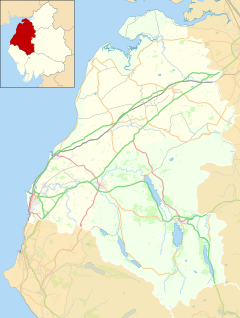
Back Cockermouth Afrikaans کوکرموث AZB Cockermouth (lungsod) CEB Cockermouth Welsh Cockermouth German Cockermouth Esperanto Cockermouth Spanish Cockermouth Basque کوکرموث Persian Cockermouth French
| Cockermouth | |
|---|---|
| Town and parish | |
 All Saints Church | |
Location within Cumbria | |
| Population | 8,761 (2011 census) |
| OS grid reference | NY121304 |
| • London | 526 km |
| Civil parish |
|
| Unitary authority | |
| Ceremonial county | |
| Region | |
| Country | England |
| Sovereign state | United Kingdom |
| Post town | COCKERMOUTH |
| Postcode district | CA13 |
| Dialling code | 01900 |
| Police | Cumbria |
| Fire | Cumbria |
| Ambulance | North West |
| UK Parliament | |
Cockermouth /ˈkɒkərmaʊθ, -əθ/[2] is a market town and civil parish in the Cumberland unitary authority area of Cumbria, England, so named because it is at the confluence of the River Cocker as it flows into the River Derwent. The mid-2010 census estimates state that Cockermouth has a population of 8,204,[3] increasing to 8,761 at the 2011 Census.[4]
Historically a part of Cumberland, Cockermouth is situated outside the English Lake District on its north-west fringe. Much of the architectural core of the town remains unchanged since the basic medieval layout was filled in the 18th and 19th centuries. The regenerated market place is now a central historical focus within the town and reflects events from its 800-year history. The town is prone to flooding and experienced severe floods in 2005,[5] 2009[6] and 2015.[7]
Mary, Queen of Scots came to Cockermouth in 1568, after her defeat at the Battle of Langside. She is said to have stayed at the house of Henry Fletcher (died 1574), who gave her a velvet gown and she later sent him a letter of thanks. Fletcher's son moved from Cockermouth to Moresby Hall in Parton, Cumbria.[8]
- ^ "Official Cockermouth Town Council & Tourist Information TIC". Official Cockermouth Town Council & Tourist Information TIC.
- ^ Pointon, Graham (1990). BBC Pronouncing Dictionary of British Names (2nd ed.). Oxford Paperbacks. p. 57. ISBN 978-0192827456.
- ^ "Mid-2010 Population Estimates for Parishes in England and Wales by Single Year of Age and Sex". Office for National Statistics. 2012. Retrieved 28 March 2015.
- ^ "Town population 2011". Neightbourhood.statistics.gov.uk. Retrieved 16 June 2015.
- ^ "Cockermouth Floods, January 2005". Bbc.co.uk. Retrieved 7 September 2019.
- ^ "The story of the Cumbrian floods". 7 December 2009. Retrieved 7 September 2019.
- ^ Kinver, Mark (7 December 2015). "Defences against the indefensible?". Bbc.com. Retrieved 7 September 2019.
- ^ Henry Manders, Moresby Hall (Whitehaven, 1875), p. 68.

